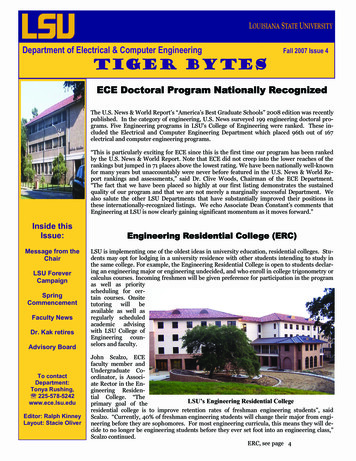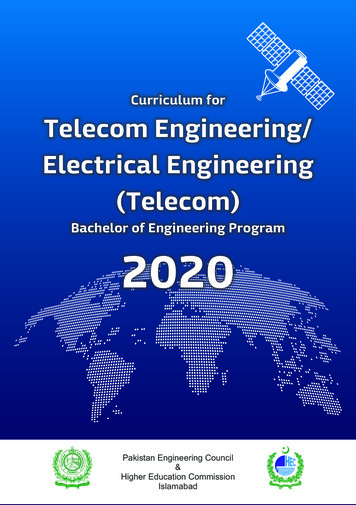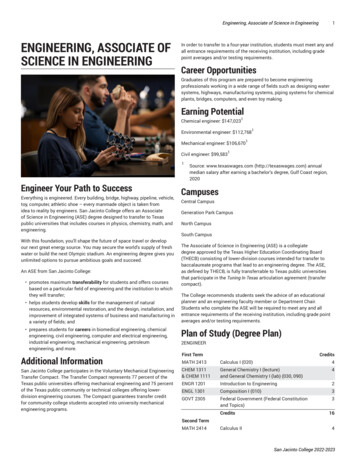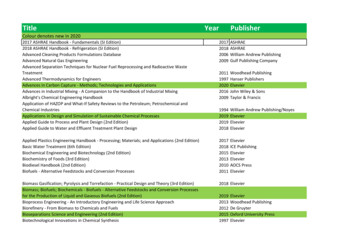
Transcription
Electrical Engineering 101Third Edition
Electrical Engineering 101Everything You Should HaveLearned in School butProbably Didn’tThird EditionDarren AshbyAMSTERDAM BOSTON HEIDELBERG LONDONNEW YORK OXFORD PARIS SAN DIEGOSAN FRANCISCO SINGAPORE SYDNEY TOKYONewnes is an imprint of Elsevier
Newnes is an imprint of Elsevier225 Wyman Street, Waltham, MA 02451, USAThe Boulevard, Langford Lane, Kidlington, Oxford, OX5 1GB, UK 2012 Elsevier Inc. All rights reserved.No part of this publication may be reproduced or transmitted in any form or by any means, electronic ormechanical, including photocopying, recording, or any information storage and retrieval system, withoutpermission in writing from the Publisher. Details on how to seek permission, further information aboutthe Publisher’s permissions policies and our arrangements with organizations such as the CopyrightClearance Center and the Copyright Licensing Agency, can be found at our website: www.elsevier.com/permissionsThis book and the individual contributions contained in it are protected under copyright by the Publisher(other than as may be noted herein).NoticesKnowledge and best practice in this field are constantly changing. As new research and experience broadenour understanding, changes in research methods, professional practices, or medical treatment may becomenecessary.Practitioners and researchers must always rely on their own experience and knowledge in evaluating andusing any information, methods, compounds, or experiments described herein. In using such informationor methods they should be mindful of their own safety and the safety of others, including parties forwhom they have a professional responsibility.To the fullest extent of the law, neither the Publisher nor the authors, contributors, or editors, assume anyliability for any injury and/or damage to persons or property as a matter of products liability, negligenceor otherwise, or from any use or operation of any methods, products, instructions, or ideas contained inthe material herein.Library of Congress Cataloging-in-Publication DataAshby, Darren.Electrical engineering 101 : everything you should have learned in school – but probablydidn’t / Darren Ashby. – 3rd ed.p. cm.ISBN 978-0-12-386001-9 (pbk.)1. Electrical engineering. I. Title. II. Title: Electrical engineering one hundred one.III. Title: Electrical engineering one hundred and one.TK146.A75 2011621.3–dc232011020171British Library Cataloguing-in-Publication DataA catalogue record for this book is available from the British Library.For information on all Newnes publications visit ourwebsite at www.elsevierdirect.comTypeset by: diacriTech, India11 12 13 14 10 9 8 7 6 5 4 3 2 1Printed in the United States of America
ContentsvPREFACE . viiABOUT THE AUTHOR . xiCHAPTER 0 What Is Electricity Really? . 1Chicken vs. Egg .1So What Is Electricity? .1The Atom .2Now What?.5A Preview of Things to Come .9It Just Seems Magical .10CHAPTER 1 Three Things They Should Have Taught in Engineering 101. 11Units Count! .11How to Visualize Electrical Components.14Learn an Intuitive Approach .19“Lego” Engineering .22CHAPTER 2 Basic Theory . 25Ohm’s Law Still Works: Constantly Drill the Fundamentals.25It’s About Time .43Beam Me Up? .54Keep It Under Control .60CHAPTER 3 Pieces Parts . 67Partially Conducting Electricity .67Power and Heat Management.77The Magical Mysterious Op-Amp .82Negative Feedback .85Positive Feedback.89It’s Supposed to Be Logical .93Microprocessor/Microcontroller Basics .105Climbing the Software Language Mountain.115Input and Output.119
viContentsCHAPTER 4 The Real World . 133Bridging the Gap.133A-to-D and Back Again.136It Takes a Little D to A to Get a Little A to D.138When Parts Aren’t Perfect .142Robust Design.148Some of My Favorite Circuits.153Get Your Own—Here Are a Few .158Power Supplies.162Making Stuff Move: The Electromechanical World.168Maintaining Speed .175Some Other Types of Motors.181CHAPTER 5 Tools. 189Making the Invisible Visible .189Simulators.196Soldering Irons .199People Tools .204CHAPTER 6 Troubleshooting . 209Getting Ready for the Hunt .209Ghost in the Machine: EMI .215Timing Is Everything .220Under Pressure.220Be Prepared for Surprises .220Code Junkies Beware.226CHAPTER 7 Touchy-Feely Stuff. 231People Skills .231Becoming an Extroverted Introvert .238Communication Skills .243Especially for Managers .247Especially for Employees.252How to Make a Great Product .256GLOSSARY . 261INDEX . 269
PrefaceviiTHE FIRST WORDIn my day job I have been lucky enough to work with one of the greatestcorporate success stories in the technical field ever. For a sparky tech nut justgoing to the Google campus was a bit like traipsing to mecca. I remembermy first tour there, and getting a “free lunch.” Our corporate contact made acomment. He said, “They’ve created some kind of engineers’ paradise over here.”I kind of wondered about that comment. Over the last couple of years I havepondered it quite a bit. I learned a lot more about what this paradise was in subsequent dealings with the king of search. They had the free food and all theseother perks but the thing that stood out most to me from the first time I heardit was 20% time. A quick Google search will tell you the details of 20% time. Theprinciple is simple: You are given 20% of your time to work on a pet project. Theproject is your choice. The only caveat is that if you come up with somethingcool Google gets to use it to make more money. In talking to contacts there Ifound out that time is sacrosanct; your management cannot demand you giveup that time for your main goals. You can volunteer it if you want to but it isup to you. In general planning, however, you and your boss plan four days aweek on your main assigned tasks and one day every week is yours.Build IntrepreneursI learned a new term recently that I think is very relevant in corporate growth andsuccess, intrepreneur. The intrepreneur is the baby brother to the entrepreneur. Thisis the guy who has that big idea and wants to change the world; he has the mentality to do so but doesn’t have the resources. Resources, in fact, is the only way inwhich they differ. The entrepreneur finds a way to resource his idea, but whetherdue to motivation or circumstance, the intrepreneur can’t quite get over that issue.Often times these are the shooting stars in your organization. The trick is to enablethese guys to make things happen. Give them the resources and turn them loose.The 20% time mentioned above is a great way of finding these individuals. Thesuccessful intrepreneur will gather others and use their 20% time to make something cool. What engineer do you know that wouldn’t consider that paradise?Engineers SuccessWhy are engineers so important to America’s success? Here is an interesting factor two: Google hires 50% engineers and 50% everyone else. Twice as manystart-up businesses are from new MIT grads than from Harvard Business Schoolgraduates (and the schools are practically right next to each other). I haven’t
viiiPrefacemet an engineer who doesn’t like to make cool things; it is in their mindset; it isin their nature; great engineers usually make pretty good money relative to theaverage Joe in America, simply because their skill set is so valued. Thing is, theyaren’t always the top-paid people, even though their contributions are oftenmuch more critical to success than that of all the management above them. Ithink this is because they get so much satisfaction out of making stuff that, aslong as they feel like they are making ends meet, things are good. This typeof person is a huge asset to the American economy. Greed doesn’t drive them,invention does, and invention leads to an improved economy more than anything else. Invention of new technology improves the standard of living foreveryone. It is the only thing that does.Google went from nothing to the top in 11 years; they themselves credit this tohiring great engineers and cutting them loose to change the world. We needmore of this. We humans have a built-in engineering gene; we love to buildand make stuff. Every kid plays with blocks, creates things, and imagines things.So why aren’t there more engineers? Is it really that hard to become one?Should it be? I hope that somebody out there reads this book and thinks,“Screw all those guys who think I’m not smart enough—I’m gonna changethe world anyway!”OVERVIEWFor EngineersGranted, there are many good teachers out there and you might have gotten thebasics, but time and too many “status reports” have dulled the finish on yourbasic knowledge set. If you are like me, you have found a few really goodbooks that you often pull off the shelf in times of need. They usually have awell-written, easy-to-understand explanation of the particular topic you needto apply. I hope this will be one of those books for you.You might also be a fish out of water, an ME thrown into the world of electricalengineering, who would really like a basic understanding to work with the EEsaround you. If you get a really good understanding of these principles, I guarantee you will surprise at least some of the “sparkies” (as I like to call them)with your intuitive insights into the problems at hand.For StudentsI don’t mean to knock the collegiate educational system, but it seems to me thattoo often we can pass a class in school with the “assimilate and regurgitate”method. You know what I mean: Go to class, soak up all the things the teacherwants you to know, take the test, say the right things at the right time, and leavethe class without an ounce of applicable knowledge. I think many students areforced into this mode when teachers do not take the time to lay the groundwork for the subject they are covering. Students are so hard-pressed to simplykeep up that they do not feel the light bulb go on over their heads or say,
Preface“A-ha, now I get it!” The reality is, if you leave the class with a fundamentalunderstanding of the topic and you know that topic by heart, you will be eminently more successful at applying that basic knowledge than anything fromthe end of the syllabus for that class.For ManagersThe job of the engineering manager1 really should have more to it than isdepicted by the pointy-haired boss you see in Dilbert cartoons. One thing manymanagers do not know about engineers is that they welcome truly insightfultakes on whatever they might be working on. Please notice I said “truly insightful;” you can’t just spout off some acronym you heard in the lunchroom andexpect engineers to pay attention. However, if you understand these basics, Iam sure there will be times when you will be able to point your engineers inthe right direction. You will be happy to keep the project moving forward,and they will gain a new respect for their boss. (They might even put away theirpointy-haired doll!)For TeachersPlease don’t get me wrong, I don’t mean to say that all teachers are bad; in fact,most of my teachers (barring one or two) were really good instructors.However, sometimes I think the system is flawed. Given pressures from thedean to cover X, Y, and Z topics, sometimes the more fundamental X and Yare sacrificed just to get to topic Z.I did get a chance to teach a semester at my own alma mater. Some of thesechapters are directly from that class. My hope for teachers is to give you anothertool that you can use to flip the switch on the “a-ha” light bulbs over yourstudents’ heads.For EveryoneAt the end of each topic discussed in this book are bullet points I like to callThumb Rules. They are what they seem: those “rule-of-thumb” concepts thatreally good engineers seem to just know. These concepts are what always ledthem to the right conclusions and solutions to problems. If you get bored witha section, make sure to hit the Thumb Rules anyway. There you will get thedistilled core concepts that you really should know.1Suggested alternate title for this book from reader Travis Hayes: EE for Dummies and Those TheyManage. I liked it, but I figured the pointy-haired types wouldn’t get it.ix
About the AuthorxiDarren Coy Ashby is a self-described “techno geek with pointy hair.” He considershimself a jack-of-all-trades, master of none. He figures his common sense camefrom his dad and his book sense from his mother. Raised on a farm andgraduated from Utah State University seemingly ages ago, Darren has morethan 20 years of experience in the real world as a technician, an engineer,and a manager. He has worked in diverse areas of compliance, production,testing, and his personal favorite, research and development.Darren jumped at a chance some years back to teach a couple of semesters athis alma mater. For about two years, he wrote regularly for the online magazineChipcenter.com. He is currently the director of electronics R&D at a billiondollar consumer products company. His passions are boats, snowmobiles,motorcycles, and pretty much anything with a motor. When not at his dayjob, he spends most of his time with his family and a promising R&D consulting/manufacturing firm he started a couple of years ago.Darren lives with his beautiful wife, four strapping boys, and cute little daughternext to the mountains in Richmond, Utah. He believes pyromania goes handin hand with becoming a great engineer and has dedicated a Facebook pageto that topic. You can email him with comments, complaints, and generalruminations at dashby@raddd.com; if all you want are tidbits of wisdomyou can follow him on Twitter under sparkyguru.
Electrical engineering 101 : everything you should have learned in school - but probably didn't / Darren Ashby. - 3rd ed. p. cm. ISBN 978--12-386001-9 (pbk.) 1. Electrical engineering. I. Title. II. Title: Electrical engineering one hundred one. III. Title: Electrical engineering one hundred and one. TK146.A75 2011 621.3-dc23 2011020171










